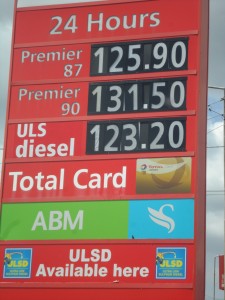 Inflation in Jamaica after rising 0.4 percent in January and March and 0.3 percent in April has now fallen to just 0.1 percent for May this year, half of the 0.2 percent rise in February.
Inflation in Jamaica after rising 0.4 percent in January and March and 0.3 percent in April has now fallen to just 0.1 percent for May this year, half of the 0.2 percent rise in February.
The increase for May brings the year to date 1.4 percent and the fiscal year-to-date to 0.4 percent. The inflation rate over the last twelve months rose to 4.6 percent. With the price of oil on the world market slipping recently, a low level of inflation can be expected for some time to come and could result in the year over year rate declining form the above level.
According to Statistical Institute of Jamaica the inflation for May is due to an increase of 0.1 percent in the index for the heaviest weighted division, Food, Non-Alcoholic Beverages and Tobacco. Within this division the group Food rose by 0.1 percent while other notable increases were recorded in the following divisions: Transport 0.2 percent, Alcoholic Beverages and Tobacco 1.6 percent and Restaurants and Accommodation Services 0.3 percent. The upward movement in the index was tempered by a 0.2 percent fall in the division Housing, Water, Electricity, Gas and Other Fuels due to lower rates for electricity, water and sewage.
Inflation rate drops in May
1.4% GDP growth for Jamaica in 2016
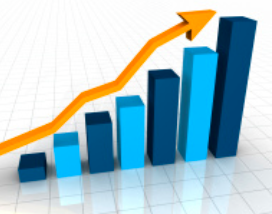 The Jamaican economy grew 1.4 percent for 2016, preliminary estimates by the Statistical Institute of Jamaica, (STATIN) the government body charged with gathering and reporting on economic data shows.
The Jamaican economy grew 1.4 percent for 2016, preliminary estimates by the Statistical Institute of Jamaica, (STATIN) the government body charged with gathering and reporting on economic data shows.
The Jamaican economy grew by 1 percent in 2015, recent data from STATIN shows. Since 2004, the closest economic growth came close to the 2016 pace, is in 2007 with 1.45 percent and 2011 with 1.7 percent.
Growth was 1.1 percent for the fourth quarter of 2016 compared to the corresponding period in 2015, representing eighth consecutive quarters of economic growth. “Increased output levels of 0.5 percent in the Services and 3.1 percent in the Goods Producing Industries contributed to the overall growth,” STATIN stated.
Growth was achieved in seven of the eight Services Industries: Electricity & Water (2.0 percent); Wholesale & Retail Trade; Repairs; Installation of Machinery & Equipment (0.2 percent); Hotels & Restaurants (2.5 percent); Transport, Storage & Communication (0.5 percent); Finance & Insurance Services (1.0 percent); Real Estate, Renting & Business Activities (0.3 percent) and Other Services (0.7 percent).
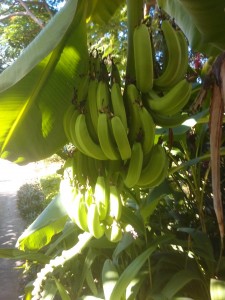 Agriculture, Forestry & Fishing, increased by a strong 17.1 percent and Construction by just 0.6 percent. STATIN said “the Agriculture, Forestry & Fishing industry was positively impacted by favourable weather conditions which resulted in higher crop yields, while the Construction industry benefitted from hotel expansion and renovation as well as the construction of office spaces to facilitate the expansion of Business Process Outsourcing activities.
Agriculture, Forestry & Fishing, increased by a strong 17.1 percent and Construction by just 0.6 percent. STATIN said “the Agriculture, Forestry & Fishing industry was positively impacted by favourable weather conditions which resulted in higher crop yields, while the Construction industry benefitted from hotel expansion and renovation as well as the construction of office spaces to facilitate the expansion of Business Process Outsourcing activities.
Decreased output was recorded in Manufacturing by 0.2 percent and Mining & Quarrying by 11.9 percent. Manufacturing decline was influenced by a 5.3 percent fall in Other Manufacturing, due largely to lower output levels in petroleum refining. The effect of the decline was tempered by a 4.9 percent rise in Food, Beverages & Tobacco sub – industry. Mining & Quarrying industry continued to be negatively affected by reduced demand for bauxite from the overseas refineries.”
Jamaica’s 2017 inflation to beat 2016 – 1.7%?
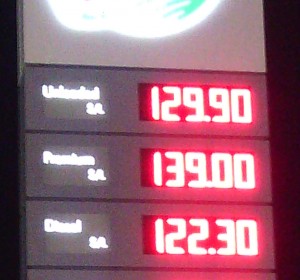
Fuel prices at the pumps in May 2015.
Inflation in Jamaica for 2016, fell to the lowest level in decades, with the Consumer Price Index showing inflation rate at just 1.72 percent for the year. The findings were released by Statistical Institute of Jamaica.
The inflation rate for 2017 could be even lower than that of 2016, if the historical patterns repeat. The 2016 out turn compares with 3.7 percent recorded for 2015. The rate for December 2016 was 0.3 percent and is just below the average of fiscal year-to-date movement of 3.1 percent to December 2016.
The rate for 2016 would have been even less, had it not been for increased taxes imposed by the government on a series of items in the first half of the year. The added increase from taxes should not recur in 2017 as revenues are running well ahead of target for the 2017 fiscal year and a pickup in growth should see a healthy increase in revenues for the new fiscal year.
In 2016, inflation in Jamaica, benefited from a continuation in tight fiscal policies, pursued by the government, but it would have been negatively affected by slippage in the exchange rate of the Jamaican dollar versus the US dollar. Moderation in energy prices helped as well.
Going forward, the country should continue to benefit from relatively low energy prices a more stable exchange rate of the Jamaican dollar as foreign exchange inflows remain strong.
Data going back to 2002 suggests that the first two months of the year tend to have flat to negative inflation. In 2015 inflation remained below the December 2014 level until April and just inching ahead in May. In 2016 it remained below the December 2015 level until July.
Doubts cast on employment rate
The Unemployment Rate for June 2016 fell to 12.9 percent, the lowest level since it hit a post 2007 high of 15.4 percent, in June 2013. It is the first time it is breaking below the 13 per cent level that it was stuck at for years. One aspect of the data raises questions about the findings.
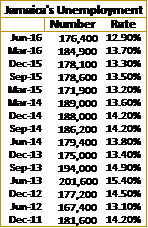 According to the Statistical Institute of Jamaica the government body charged with collecting and collating economic data on the country. ”There were 1,186,900 employed persons in July 2016 which was 39,400 more than the 1,147,500, recorded in July 2015. The industry group Wholesale & Retail, Repair of Motor Vehicle & Equipment had the largest gain (13,300) in employment moving from 220,200 in July 2015 to 233,500 in July 2016. For the same period the industry group Agriculture, Hunting, Forestry & Fishing had the largest decline (14,000), moving from 205,200 to 191,200. The industry group Construction had the largest increase in the number of males (10,200) and the groups Manufacturing (7,100) and Other Community, Social and Personal Service Activities (7,100) accounted for the largest increase in the number of females in the period.”
According to the Statistical Institute of Jamaica the government body charged with collecting and collating economic data on the country. ”There were 1,186,900 employed persons in July 2016 which was 39,400 more than the 1,147,500, recorded in July 2015. The industry group Wholesale & Retail, Repair of Motor Vehicle & Equipment had the largest gain (13,300) in employment moving from 220,200 in July 2015 to 233,500 in July 2016. For the same period the industry group Agriculture, Hunting, Forestry & Fishing had the largest decline (14,000), moving from 205,200 to 191,200. The industry group Construction had the largest increase in the number of males (10,200) and the groups Manufacturing (7,100) and Other Community, Social and Personal Service Activities (7,100) accounted for the largest increase in the number of females in the period.”
The big question is how is it possible for agriculture to have grown by a massive 38 percent, according to data from the Planning Institute of Jamaica and for there to be a major fall in employment in that category? The more likely situation is that employment grew sharply in the agricultural sector, resulting in a much greater fall in unemployment, assuming the estimate for growth in agriculture is correct.
BOJ should cut inflation forecast
 Inflation rate in Jamaica remains at a low level for October with the rate receding from 0.5 percent in September to 0.2 percent in the latest compilation by the Statistical Institute of Jamaica (Statin).
Inflation rate in Jamaica remains at a low level for October with the rate receding from 0.5 percent in September to 0.2 percent in the latest compilation by the Statistical Institute of Jamaica (Statin).
The rate of inflation for the calendar year-to-date was 1.1 per cent, while increase for the last twelve months to October is up 1.8 percent. The fiscal year-to-date registered an increase of 2.4 percent and is running well below the central bank’s forecast of 4.5 to 6.5 percent.
The month by month increase for 2016, should end just under 2 percent for the full year, suggesting that its time the central bank adjusts their fiscal rate target sharply down, with the price of oil under pressure and the prospect that electricity rates should decline with Jamaica Public Service switching to LNG to power their Bogue plant.

The fiscal deficit was wiped out by Peter Phillips as Minister of Finance after his fellow minister Omar Davies ran up huge deficit an high inflation under his watch
Higher prices for vegetables and starchy Foods’ with an increase of 1.6 percent and movement for the division ‘Transport’ mainly attributable to higher prices for petroleum locally impacted the overall increase in inflation. A decline in electricity rates charged to consumers helped to moderate the increase.
The continued low inflation is aided by a fall in oil prices and other commodities on the world market but most telling, is the elimination of the huge government fiscal deficit in the past. The large deficit helped to fuel high levels of inflation and severe instability in the rate of exchange for the local currency.
Jamaican GDP doubles 2015 growth

Image courtesy of arztsamui/FreeDigitalPhotos.net
The economy that rose by 0.8 percent in the March quarter over the similar period in 2015 is up by 1.4 percent for the second quarter of 2016, compared to the similar quarter of 2015. If the trend were to continue, growth for the full year could hit 2 percent, the fastest pace of growth since 2006 with growth of 2.9 percent. The only other time since 2004 that the economy grew close the 2016 pace is 2007 when the economy grew by 1.45 percent and 1.43 percent in 2011.
Growth in 2015 over 2014 reflected an increase of 0.4 percent in the March quarter and 0.8 percent for the second quarter.

Agriculture added the most to GDP in Q2
Inflation set to fall below 2% for 2016

Fuel prices at the pumps in May 2015.
The calendar year-to-date inflation is only 0.3 percent, while the year over year movement is 1.8 percent. IC Insider is forecasting the full year inflation to end just below 1.5 percent, barring major negative developments. If the forecast is closely achieved, it would be the lowest rate in four and a half decades and will better the 3.66 percent achieved in 2015, the previous lowest rate over the same period. The rate for 2016 would be well below the 4.2 percent forecast by the IMF for the calendar year and the Bank of Jamaica the fiscal year forecast to March 2017 with a target of 4.5 percent to 6.5 percent.
 According to Statin, inflation for August was driven mainly by the division ‘Housing, Water, Electricity Gas and Other Fuels’ which recorded the highest movement, 1.8 percent, primarily due to the increase in rates for electricity and water. The group ‘Food and Non-Alcoholic Beverages’ division increased by 0.4 percent and was influenced by the upward movement in the group ‘Vegetables and Starchy Foods’ up by 0.9 percent. The increases were partially offset by a fall in ‘Transport’ by 0.2 percent, due to lower petrol prices on the local market for the month of August.
According to Statin, inflation for August was driven mainly by the division ‘Housing, Water, Electricity Gas and Other Fuels’ which recorded the highest movement, 1.8 percent, primarily due to the increase in rates for electricity and water. The group ‘Food and Non-Alcoholic Beverages’ division increased by 0.4 percent and was influenced by the upward movement in the group ‘Vegetables and Starchy Foods’ up by 0.9 percent. The increases were partially offset by a fall in ‘Transport’ by 0.2 percent, due to lower petrol prices on the local market for the month of August.The low level of inflation comes against the back ground of a 5 percent devaluation of the Jamaican dollar versus the US dollar and a tax package earlier in the year that saw an increase in the price of petroleum as well as a fiscal deficit that is close to zero and well below forecast.
40,100 Jamaicans found jobs

Staff at Derrimon Trading.
The unemployment rate decreased for men from 10.3 percent to 9.6 percent but women had a big setback with unemployment for them increasing from 16.8 percent to 18.4 percent.
The year over year change resulted in the Employed Labour Force for March 2016 was 1,168,600 up from 1,128,500 reported in March 2015 and left the Unemployment Rate for March 2016 at 13.7 percent an increase of 0.5 percentage points when compared to the March 2015 rate of 13.2 percent.
 According to Statin, “the industry group “Wholesale and Retail, Repairs of Motor Vehicle and Equipment” provided employment for the majority (253,400) of the employed persons. This industry provided employment for the majority of females (117,100) but the largest number of males (157,100) were employed in the industry group “Agriculture, Hunting, and Forestry & Fishing”.
According to Statin, “the industry group “Wholesale and Retail, Repairs of Motor Vehicle and Equipment” provided employment for the majority (253,400) of the employed persons. This industry provided employment for the majority of females (117,100) but the largest number of males (157,100) were employed in the industry group “Agriculture, Hunting, and Forestry & Fishing”.The number of persons classified as being outside the Labour Force fell by 49,000 (6.3 percent) to 735,400 in the March 2016 survey bringing the number of persons in the Labour Force to 1,353,500, which was 53,100 (4.1 percent) greater than the 1,300,400 recorded in March 2015.
Price increases slowed in July
 With more than half of the calendar year gone, overall price movements in Jamaica remained slightly negative at minus 0.1 percent, but inflation for the last twelve months amounts to 2.1 percent, while inflation since April is up 1.2 percent.
With more than half of the calendar year gone, overall price movements in Jamaica remained slightly negative at minus 0.1 percent, but inflation for the last twelve months amounts to 2.1 percent, while inflation since April is up 1.2 percent.
The rise in the Inflation Rate since April 2016, emanated mainly from 0.5 percent rise in prices in July 2016, according to the latest figures released by the Statistical Institute of Jamaica and a 0.9 percent movement in June.
July’s prices were mainly impacted by Electricity, Gas and Other Fuels rising 4.6 percent and Water Supply and Miscellaneous Services Related to the dwelling climbing 2.8 percent.

Increased fuel prices added to inflation.
Food and Non-Alcoholic Beverages increased by a mere 0.3 percent due mainly to increased prices for vegetables and starchy foods. Price movements elsewhere for July were mild.
The decline in the price of oil on the world market in recent weeks should have a moderating effect on prices overall in August and September. Regardless, if inflation were to remain at the 0.5 percent per month as occurred in July the country is likely to enjoy one of the lowest year of inflation for some time and Jamaica seems set to report an inflation rate that is below 2 percent for 2016.
Prices up during May in Jamaica
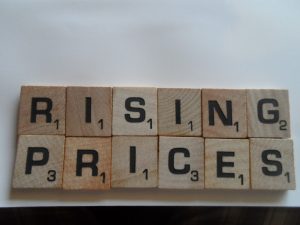 Prices mostly rose in May resulting in Jamaica experiencing an inflation rate of 0.2 percent for the month over April this year with the calendar year to date figure still showing no signs of higher prices overall, with negative inflation of 1.4 percent, data from the Statistical Institute of Jamaica (STATIN) reveal.
Prices mostly rose in May resulting in Jamaica experiencing an inflation rate of 0.2 percent for the month over April this year with the calendar year to date figure still showing no signs of higher prices overall, with negative inflation of 1.4 percent, data from the Statistical Institute of Jamaica (STATIN) reveal.
According to STATIN, the main contributors to overall upward movement in May, were Food and Non-Alcoholic Beverages up by 0.1 percent, Housing, Water, Electricity, Gas and Other Fuels up by 0.6 percent and the Transport division advancing by 0.8 percent. The point-to-point movement, that is, inflation for the past year, is 2.1 percent.
“Mainly impacting the index for the division Food and Non-Alcoholic Beverages are increases of 0.1 percent and 0.3 percent in the index for the groups, Food and Non-Alcoholic Beverages respectively.
Other areas of price increase are, Alcoholic Beverages and Tobacco 0.1 percent, Clothing and Footwear 0.3 percent, Furnishings, Household Equipment and Routine Household Maintenance 0.3 percent, Health, 0.1 percent, Recreation and Culture 0.1 percent and Miscellaneous Goods and Services 0.2 percent. There were no increases for Education, Communication, Restaurants and Accommodation Services.
- « Previous Page
- 1
- …
- 3
- 4
- 5
- 6
- 7
- Next Page »
